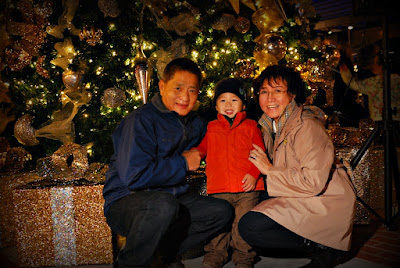*********

Lighting is absolutely essential for holiday photos. Specifically, there are at least three lighting aspects that are important for holiday photos: sufficient ambient light, moderate key light, and key light color temperature. In an outdoor holiday shot, the holiday lights are easily visible but aren't bright enough by themselves to illuminate the subject without using a flash. For our purposes, that makes things easier. Here's a step-by-step process I used for the photo above.
1. Sufficient ambient light.
a. I switched to manual exposure mode for greater control.
b. I chose an ISO that is as high as I'm comfortable with. In dim lighting conditions like this, the higher the ISO, the more exposure options you have available for your aperture and shutter generally speaking. However, if your ISO is too high, you run into two issues - noise and having too much flash exposure (when ISO is too high, even the minimum flash output may still be too bright). Here I chose 1000.
c. I chose the widest acceptable aperture. Because this was a group shot, I wanted to make sure enough of the subjects were sufficiently in focus, so I chose f/4.0. If this was a solo shot, I would have chosen f/2.8 (that's the widest aperture I have on my lens).
d. I took a test shot of the background lights with no flash and used my shutter speed to set the amount of ambient that I felt looked good (usually at a slight underexposure to keep the subjects more prominent than the background). In this case, I adjusted my shutter until I was satisfied with a shutter of 1/25.
2. Moderate key light.
With the exposure set for the ambient, I could now ask my subjects to get in the picture and pose. Again, in these conditions, the holiday lights wouldn't be enough to illuminate the subjects. Thus, we'll need to use a flash for the subjects.
a. If possible, use off-camera flash. On-axis flash (such as a popup flash) looks unnatural because there's no reasonable explanation for the direction of light. In the shot above, I used Nikon CLS to trigger my flash off-camera.
b. Whether you use off-camera flash or on-camera flash, it's crucial to avoid excess flash exposure. In TTL mode, decrease flash exposure compensation if the flash is too bright in the photo. Here, I did not feel the need to decrease the flash exposure compensation.
3. Key light color temperature.
Most holiday lights are yellowish in color. Flash is normally slightly blue. Without adjusting the flash's color temperature, the flash will look very different from the background lights and will look unnatural. The solution is simply to use a gel (here, I used a 1/4 CTO gel from the Rosco sampler pack taped onto the front of my flash. If you don't have a gel with you, you can instead make the color temperature warmer in postprocessing. The holiday lights will look more reddish, but at least the flash color won't be unnatural.

No comments:
Post a Comment
Thanks for your comment. It will be published as soon as we get a chance to review it, sorry for that, but we get lots of spam with malicious links.